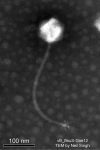The life cycle of SPβ and related phages
- PMID: 34100162
- PMCID: PMC8270828
- DOI: 10.1007/s00705-021-05116-9
The life cycle of SPβ and related phages
Abstract
Phages are viruses of bacteria and are the smallest and most common biological entities in the environment. They can reproduce immediately after infection or integrate as a prophage into their host genome. SPβ is a prophage of the Gram-positive model organism Bacillus subtilis 168, and it has been known for more than 50 years. It is sensitive to dsDNA damage and is induced through exposure to mitomycin C or UV radiation. When induced from the prophage, SPβ requires 90 min to produce and release about 30 virions. Genomes of sequenced related strains range between 128 and 140 kb, and particle-packed dsDNA exhibits terminal redundancy. Formed particles are of the Siphoviridae morphotype. Related isolates are known to infect other B. subtilis clade members. When infecting a new host, SPβ presumably follows a two-step strategy, adsorbing primarily to teichoic acid and secondarily to a yet unknown factor. Once in the host, SPβ-related phages pass through complex lysis-lysogeny decisions and either enter a lytic cycle or integrate as a dormant prophage. As prophages, SPβ-related phages integrate at the host chromosome's replication terminus, and frequently into the spsM or kamA gene. As a prophage, it imparts additional properties to its host via phage-encoded proteins. The most notable of these functional proteins is sublancin 168, which is used as a molecular weapon by the host and ensures prophage maintenance. In this review, we summarise the existing knowledge about the biology of the phage regarding its life cycle and discuss its potential as a research object.
© 2021. The Author(s).
Conflict of interest statement
The author declares no conflict of interest.
Figures




Similar articles
-
Closely related and yet special - how SPβ family phages control lysis-lysogeny decisions.Trends Microbiol. 2025 Apr;33(4):387-396. doi: 10.1016/j.tim.2024.11.007. Epub 2024 Dec 6. Trends Microbiol. 2025. PMID: 39645480 Review.
-
The Bacillus phage SPβ and its relatives: a temperate phage model system reveals new strains, species, prophage integration loci, conserved proteins and lysogeny management components.Environ Microbiol. 2022 Apr;24(4):2098-2118. doi: 10.1111/1462-2920.15964. Epub 2022 Mar 15. Environ Microbiol. 2022. PMID: 35293111
-
Developmentally-regulated excision of the SPβ prophage reconstitutes a gene required for spore envelope maturation in Bacillus subtilis.PLoS Genet. 2014 Oct 9;10(10):e1004636. doi: 10.1371/journal.pgen.1004636. eCollection 2014 Oct. PLoS Genet. 2014. PMID: 25299644 Free PMC article.
-
Structural and functional characterization of MrpR, the master repressor of the Bacillus subtilis prophage SPβ.Nucleic Acids Res. 2023 Sep 22;51(17):9452-9474. doi: 10.1093/nar/gkad675. Nucleic Acids Res. 2023. PMID: 37602373 Free PMC article.
-
Host control by SPβ phage regulatory switch as potential manipulation strategy.Curr Opin Microbiol. 2023 Feb;71:102260. doi: 10.1016/j.mib.2022.102260. Epub 2022 Dec 27. Curr Opin Microbiol. 2023. PMID: 36580707 Review.
Cited by
-
Arbitrium communication controls phage lysogeny through non-lethal modulation of a host toxin-antitoxin defence system.Nat Microbiol. 2024 Jan;9(1):150-160. doi: 10.1038/s41564-023-01551-3. Epub 2024 Jan 4. Nat Microbiol. 2024. PMID: 38177304
-
Characterization of a FourU RNA Thermometer in the 5' Untranslated Region of Autolysin Gene blyA in the Bacillus subtilis 168 Prophage SPβ.Biochemistry. 2023 Oct 17;62(20):2902-2907. doi: 10.1021/acs.biochem.3c00368. Epub 2023 Sep 12. Biochemistry. 2023. PMID: 37699513 Free PMC article.
-
Luteibacter flocculans sp. nov., Isolated from a Eutrophic Pond and Isolation and Characterization of Luteibacter Phage vB_LflM-Pluto.Microorganisms. 2023 Jan 24;11(2):307. doi: 10.3390/microorganisms11020307. Microorganisms. 2023. PMID: 36838271 Free PMC article.
-
Insights into the modulation of bacterial NADase activity by phage proteins.Nat Commun. 2024 Mar 27;15(1):2692. doi: 10.1038/s41467-024-47030-z. Nat Commun. 2024. PMID: 38538592 Free PMC article.
-
A model industrial workhorse: Bacillus subtilis strain 168 and its genome after a quarter of a century.Microb Biotechnol. 2023 Jun;16(6):1203-1231. doi: 10.1111/1751-7915.14257. Epub 2023 Apr 1. Microb Biotechnol. 2023. PMID: 37002859 Free PMC article. Review.
References
Publication types
MeSH terms
LinkOut - more resources
Full Text Sources
Molecular Biology Databases
Research Materials

